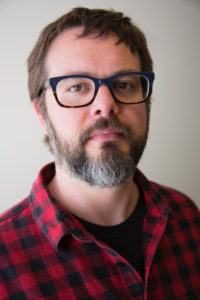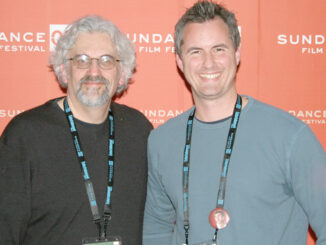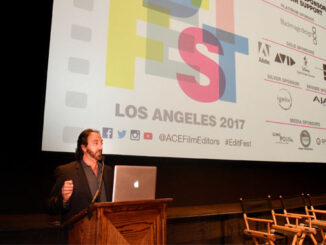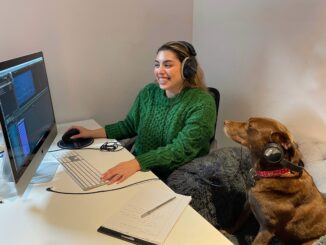
“Joker” hits theaters this Friday, and it’s already the year’s most-talked-about film.
Directed by Todd Phillips and starring Joaquin Phoenix in the title role, the movie explores the backstory of the villain from the Batman stories depicted in the DC Comics franchise and its numerous film and TV adaptations.
At the Venice International Film Festival in August, “Joker” received an 8-minute standing ovation and the Golden Lion award. Boxoffice tracking suggests the movie might score a record $90 million-plus opening in its first weekend.
CineMontage interviewed Guild member Jeff Groth, who edited “Joker,” about how he got the job, the importance of the Batman canon, and the problems of depicting blood onscreen. [Caution: Mild spoilers follow.]
How did you first get involved in “Joker”? What were your reactions when you first read the script?
Groth: I met Todd on “Project X” where he was a producer. We then worked on “The Hangover Part III” and “War Dogs” together. I loved the script when I first read it; the story always folds back in to Arthur, and the use of the Batman elements is so original and yet familiar. It was very clear to me the movie Todd wanted to make, and it was very much a movie I wanted to edit.

This film is part of a DC comics mythology. How did that figure in how you approached the material? Were you thinking of the Batman mythos, or did you approach the film as its own thing?
It figured in, in that we wanted to do something different, not just from Batman, but from all comic-based films. It’s a fictional world, but grounded in reality and people’s actions have real consequences. Staying true to some aspect of the Batman canon was always secondary to making a bold movie.
What was your working relationship with Todd on the film? Was he in the room a lot, or did he just give you a general direction and then leave you on your own? How was the process different during initial assembly than at later stages?
He’s there all the time; he wants to be part of the process, and he enjoys editing. Todd also knows how to run the machine, so he can watch and understand what I’m doing as I’m doing it. There is a significant amount that doesn’t have to be explained; we’ll discuss what we want to achieve and then I can set about doing it. Given his knowledge of the mechanics, Todd’s then able to respond to what I’m doing in real-time. We spend a lot of time experimenting.
What were the most difficult scenes to cut, and why? What specific problems did you have to overcome that were, in your experience, unique to this project?
The first scene with Arthur and the social worker [where she interviews him about his personal problems]. There was so much information in the first cut of that scene that we were constantly reevaluating what needed to be said, why and how it should be conveyed.
The scene with him and his mother in the bathroom [where Arthur washes her hair as she bathes] took the most work to actually place in the narrative.
The biggest challenge was how to “loosen the leash” on Arthur, step by step, so that he never jumped too far ahead, and so we wouldn’t reveal information ahead of its time.
What scenes were the most fun to cut, and why?
Arthur practicing for the Murray Franklin show, playing with the sound of the audience moving from the TV to his head.
Also, the scene when Randall and Gary come to visit near the end. It’s got tension, horror, humor and tension again all in the course of a couple minutes, and it leaves you not knowing quite what to think. Then also the next scene – the dancing on the stairs and chase.
How involved were you in the music and sound cutting? Did you use temp music that did or did not make it into the final cut, and what happened during that decision-making process?
Very involved. That’s part of it. My first assembly always has temp score and temp sound effects. Once it’s shot, Todd wants to see what it looks like as a real movie. Our composer, Hildur, had done several pieces based on reading the script, so I had those prior to shooting, and that all made it into the film, as well as pieces she would continue to compose throughout the production. We would take those pieces, along with tracks from her albums and other scores she had done, and recut and rearrange them to make a complete sound and feel until it was time to put together final score and record.
What visual effects presented the stiffest obstacles? How did you solve those?
The period look, erasing and replacing all the modern things from the environment; there was a lot to find and change. Also making sure the blood looked real. We just kept working on that until it looked right.
There are no CG characters; you’re not meant to feel like we did a lot with VFX.
“Joker” contains some graphic scenes –notably, a sequence with Murray Franklin, the talk-show host played by Robert De Niro. How did you approach that scene and others? How did you handle that shocking element in cutting it?
As far as the Murray Franklin show goes, you’ve got two heavyweights on stage there, and on one side you’ve got Joker deciding what he’s going to do, on the other side is Murray and you’re wondering when he’s going to figure out what he’s really dealing with. There are definitely earlier scenes leading you to what the Joker might be planning to do on that stage and in the cutting we recalled a couple pieces of score there to emphasize that.
Critics have already praised the complexity and energy of Joaquin’s performance. Did the actor give you many options in cutting, or was there a main thru line in the whole performance? How did you find the right take among the options you were given?
It was kind of infinite options. Joaquin was free to experiment, so he did – a lot – and what we found was that it was all valid, so there was a thru line in that he was always Arthur or Joker (or frequently a combination of the two). During production, I cut the scenes in order as much as possible so that we could watch his transformation in order (as much as possible) and see if there were any beats missing. Finding the right takes sometimes meant two or three completely different performances of the same scene cut together, and then waiting to see what the context of that scene became in the movie as a whole.
The movie has already provoked intense reactions. What do you hope audiences take away or experience from this film?
I hope that it affects them, and makes them think about the world around them. I hope that it’s still in their heads the next day.





